Choosing the best location for a gym is an important decision. With the right know-how and support, you’ll be certain of selecting the best possible location when opening a gym. How do you get started and what do you need to consider? Let’s take a look!
Location matters.
Where your gym is located can have a big impact on how successful your fitness business will be. So, it’s fair to say that choosing gym location is pretty much the biggest decision you’ll have to make when opening a new gym.
When you’re considering owning a gym for the first time (or expanding to a new location) it can be tempting to go on gut instinct. Opening a gym in a location in your hometown, or a place you know well, might seem to make sense.
But, it’s a risky approach.
Want to find the best location for a gym? You’re in the right place! We’ve partnered with the experts to create the ultimate guide to choosing a location when starting a gym.
Let’s get stuck in!
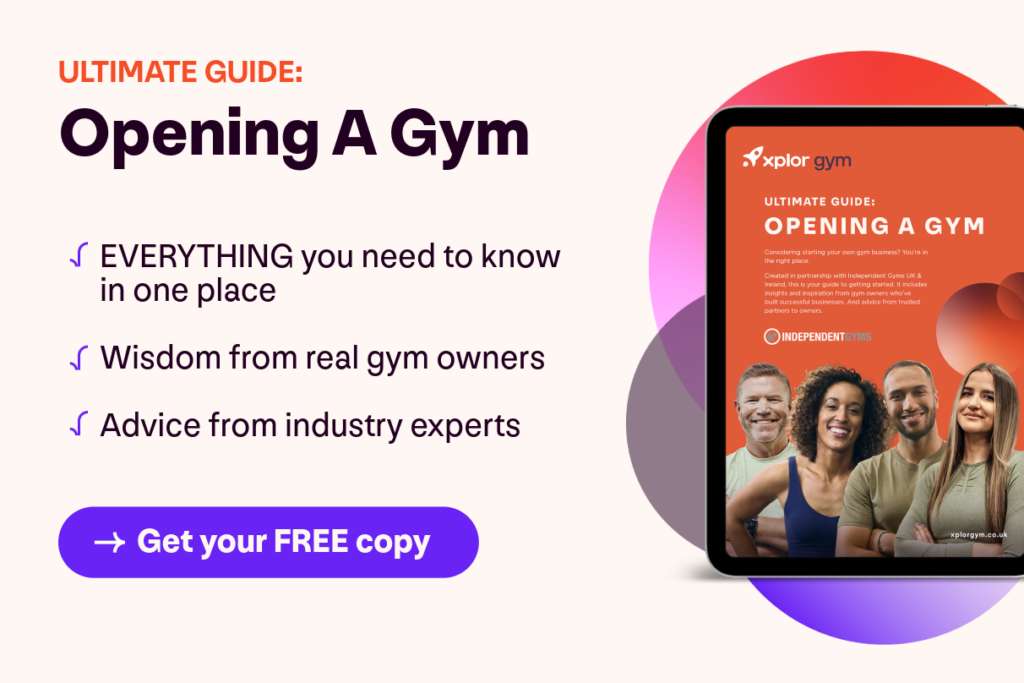
The most effective way to find the best location for a gym
There are many factors that influence the best places to open a gym. You’ll need to consider:
- Your target audience
- Ease of access
- Legal considerations
- Building logistics
- Parking needs
- Local competition
- Cost
- The list goes on!
How can you really tell that a location will work for your new club? The answer is simple – look at latent demand.
What is latent demand?
Good question! According to the Cambridge Dictionary, latent demand is:
“Demand for a product or service that a consumer cannot satisfy because they do not have enough money, because the product or service is not available, or because they do not know it’s available.”
In short, there’s latent demand in locations where consumer demand for gyms and fitness clubs is not yet met. It helps you understand how many members you’d realistically be able to attract. All based on opening your gym in a specific location.
And why is it so important when choosing a gym location?
Latent demand opens up your eyes. It gives you a genuine idea of just how many people would be willing to join your gym. No guess work needed!
Being able to accurately forecast demand will help you know whether you stand a chance of success in your favoured location.
Need to attract funding and investment to cover the cost of opening a gym like most new gyms do? Providing details of latent demand will reassure your finance partners. And even give you a lot of the info you’ll need to create a compelling gym business plan.
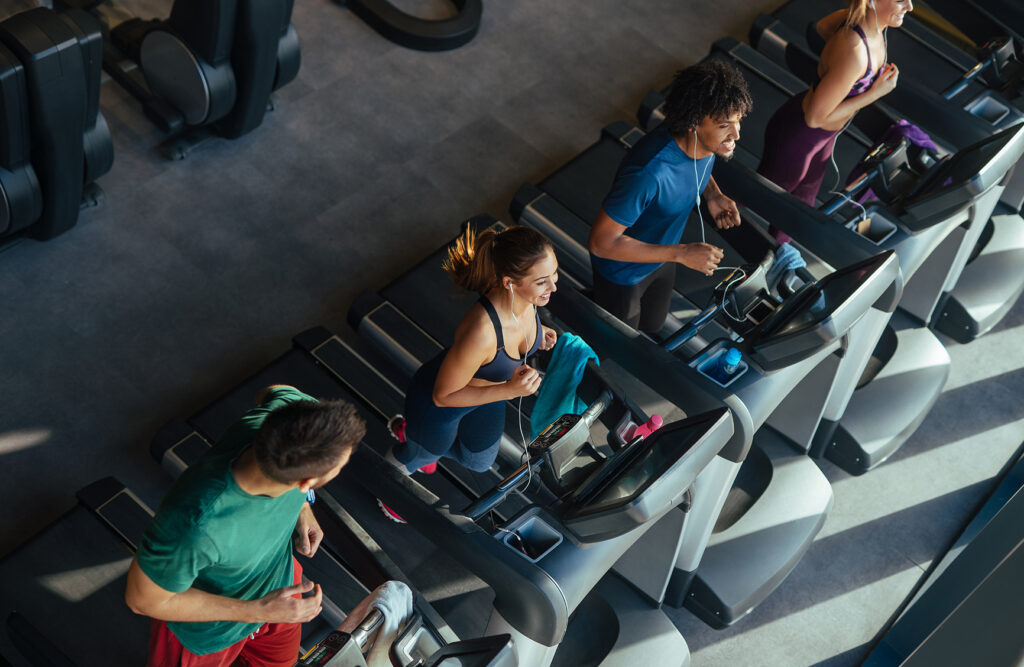
Accurately predict potential to find the best location for a gym
So, how do you work out that there’s enough demand for the gym you’re planning to open at the location you’ve found? How do you know the potential to build a profitable business exists?
Invest in a latent demand report. It’s the best way to get a comprehensive site analysis covering the gym location you’re looking at. And when looking at options to access this type of insight, it’s vital to rely on the right partner.
Good news! There’s no need to shop around if you want to really know that a specific location is the best option for your new gym. You can rely on a partner with unmatched experience in analysing realistic demand for clubs across the UK.
Tapping into 20+ years of experience, with the data to back it up, only Leisure DB is able to truthfully tell you if a site is the best location for your new gym.
What do the most successful operators and owners, have in common? Leisure DB is the only independent market intelligence company they trust. And the first port of call when considering new gym locations.
“Opening a new gym is a serious investment for owners. Location has the power to make or break how successful a club will be. Understanding latent demand is the key to realistically knowing how successful you may be if you open a club in a specific location.”
Natalie Gibson, Leisure DB
Want to see what a latent demand report includes?
SampleUsing an example club, Leisure DB have created a sample report to show you what to expect when you invest in a latent demand report for your new gym.
View the sampleCalculating demand for a specific gym location – how it works
Understanding whether a specific location is the best place to open a gym starts with having a site in mind. And an idea of the type of gym or fitness club you want to run.
Armed with this info, Leisure DB can work with you to help you understand exactly how many members you’d be able to attract. As UK specialists, the insight you’ll rely on is unbeatable:
- 20+ years of fitness industry experience
- Comparable data on approx. 7,000 fitness gym locations
- Profiles of millions of real gym members
- 450+ consumer classification data variables (using Mosaic, Experian’s segmentation system)
Calculations are influenced by demographics. Local competition. And the plans you have for your club – size, price point, facilities, target audience, etc.
Taking the plunge and opening your own business is a big investment. It’s a risk. The insights you get with this type of report will be the most accurate, realistic way to work out whether you should go ahead with it at the location you’ve found.
“Every variable about your planned business and chosen location matters. Change one variable and the number of members you can realistically attract changes with it.
We get to know and understand exactly what the plans for your new gym or fitness club are. So, we can provide you with detailed, accurate forecasts.”
Natalie Gibson, Leisure DB
Want to understand more about what you can expect? Here’s how the process of working out realistic demand for your club in your proposed location works:
1: Identify a realistic catchment area
The first step is to work out a catchment area for your gym location. This means working out how far people are likely to travel to use your club. And seeing how big the population is within that area.
“Experience shows us that there are many factors that can influence catchment areas for gyms. And we know that every site is different.
It’s not purely about drive time, population clusters, or where competitors are. It’s about what you are offering and for what price. It’s also about geography, natural boundaries, and man-made features.”
Natalie Gibson, Leisure DB
2: Understand who’s in that area
Next, it’s time to look at exactly who is in your catchment area and really get to know these potential gymgoers.
Using Experian’s Mosaic segmentation groups and types is the best way to get a really clear picture of your location.
Based on 450+ data variables, this way of looking at consumers covers 15 high level groups that break down into 66 detailed types. The groups give you a good feel for an area. And the types give you even more detail.
“Working at the more detailed level of Mosaic types means we can be even more accurate and provide value – really diving into the specifics.
As well as showing the dominant types in a catchment area, we include all types to show you how important they are for your planned club.”
Natalie Gibson, Leisure DB
You’ll get a breakdown showing:
- The number of people in each Mosaic type in your catchment area
- The % of your catchment population that makes up
- And details of how that compares to the nation overall
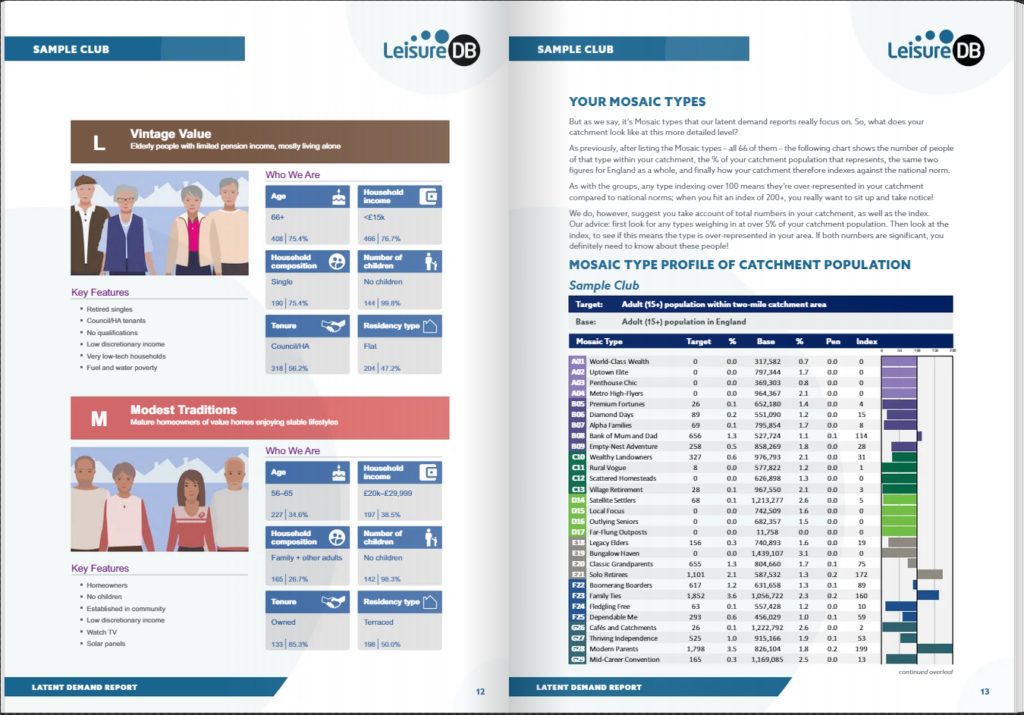
Plus, this stage of the process will give you info about the groups and types close to the location you’re investigating. So you’ll know:
- Age
- Stage of life
- Wealth
- Home ownership status & type of property
- Parental status
- Holiday habits
- Shopping habits
- Social media use
- And more!
3: Get a visual view
The next step is to put it on a map. So, you’ll understand more about your catchment population. And see exactly where each Mosaic group lives.
Plus, a competition map will be created. This’ll show you where all open and soon-to-open gyms (and pools) are in your area. And give details of their offering and pricing.
“The fitness industry is constantly changing. For example, new clubs open, sites are taken over by new management, offerings change, and pricing is updated.
So, the Leisure DB research team is dedicated to keeping our information up-to-date. We are constantly updating our data to incorporate changes as they happen.
That means the competitor insights we provide are always accurate.”
Natalie Gibson, Leisure DB
This competitive analysis will give you all the info you need on your local competitors. So, you won’t need to do your own analysis for these operators!
Together, the Mosaic map and competition map will draw your attention to important considerations. You’ll be able to see if a specific group or type of consumer is really an opportunity for your business. Or if they’re already catered for.
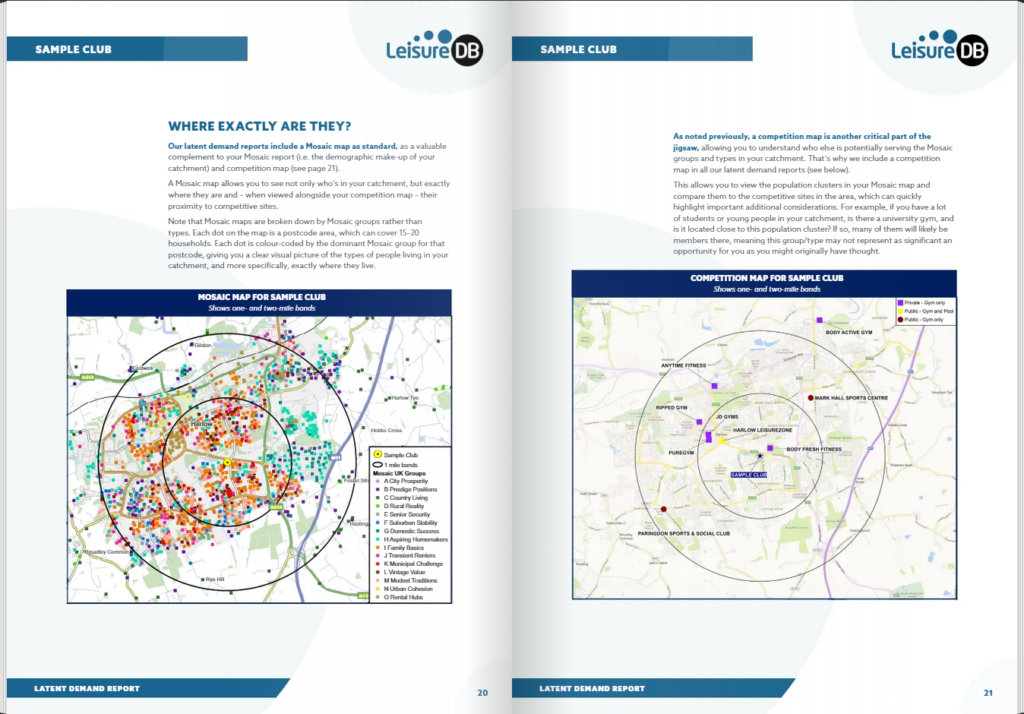
4: Calculate demand
A catchment area has been created. The local population has been analysed. And a clear picture of your competition has been painted.
So, the final step is to work out how many members you’re likely to attract to your new gym. And then you can take the guess work out of deciding if it’s the best location for you.
This calculation should have a robust model behind it. A model that’s informed by:
- Everything known about the approx. 7k fitness facilities in the UK today
- Data about millions of members – who they are, how far they’re travelling to the gym, etc.
And one that continually changes and updates to give you an accurate prediction based on your chosen location. And your plans for your club. Benchmarking you against comparable clubs across the UK.
“How big is your planned gym? What facilities – like a group fitness studio – will you have? Whereabouts in the UK will it be? What will you charge? Who is in your catchment area?
Each of these factors will impact how many members you’ll be able to attract.
All of this is built into our forecast. We only take learnings from clubs that can be compared to your planned gym. And realistically show how your planned club will appeal to different demographic groups in your catchment area.”
Natalie Gibson, Leisure DB
You’ll get a forecast of the total number of members that your club could achieve. A demand forecast that’s as accurate as it can possibly be. And realistic too.
“This isn’t about stretch goals. It’s about what’s actually feasible. So, your expectations are realistic. And you can make critical decisions – like choosing the best location for your gym – with confidence.”
Natalie Gibson, Leisure DB
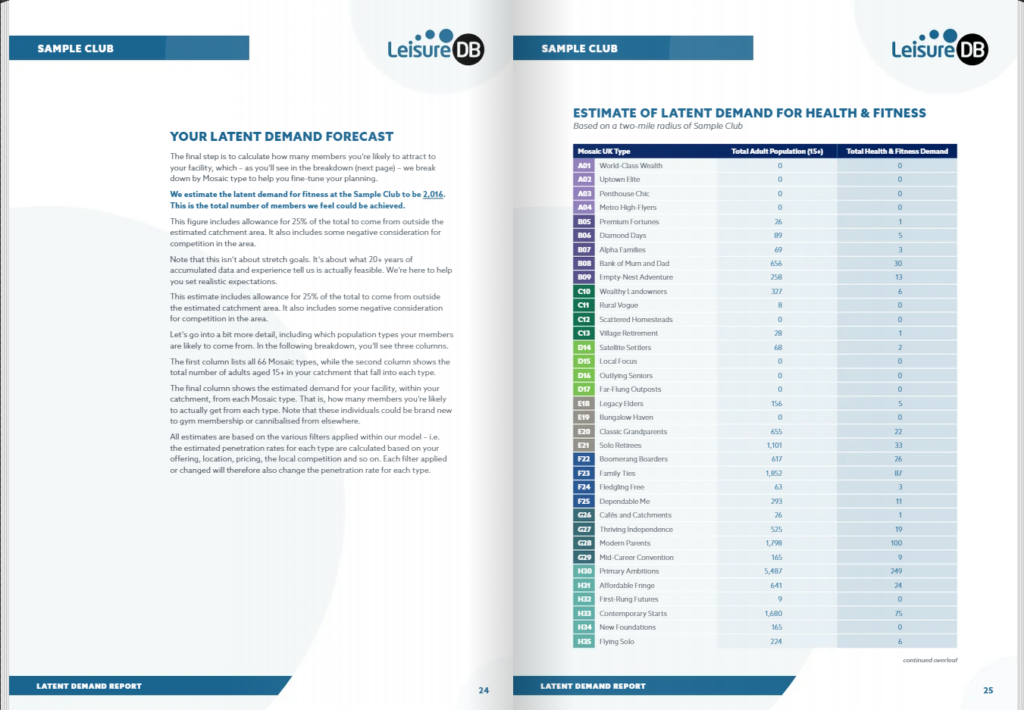
Get a report for your new gym
DiscountAs a Leisure DB partner, the Xplor Gym team is able to introduce you to the Leisure DB team. And help you secure a preferable rate on your latent demand report.
Contact us to learn moreWhat to consider when finding the best location for a gym
Understanding how many members you can realistically win is the most reliable way to know you’ve found the best location for a gym.
And there are some general factors you can look at. Consider these when you’re finding locations initially:

Target audience
There are many different types of gymgoer. And it’s tempting when you’re opening a new gym to target everyone. However, if you want to differentiate your business and build loyal members, you should be more specific about your audience.
Knowing who you’re trying to attract will help you identify possible locations. So, you’ll find gym locations that tick the right boxes for your prospective members.
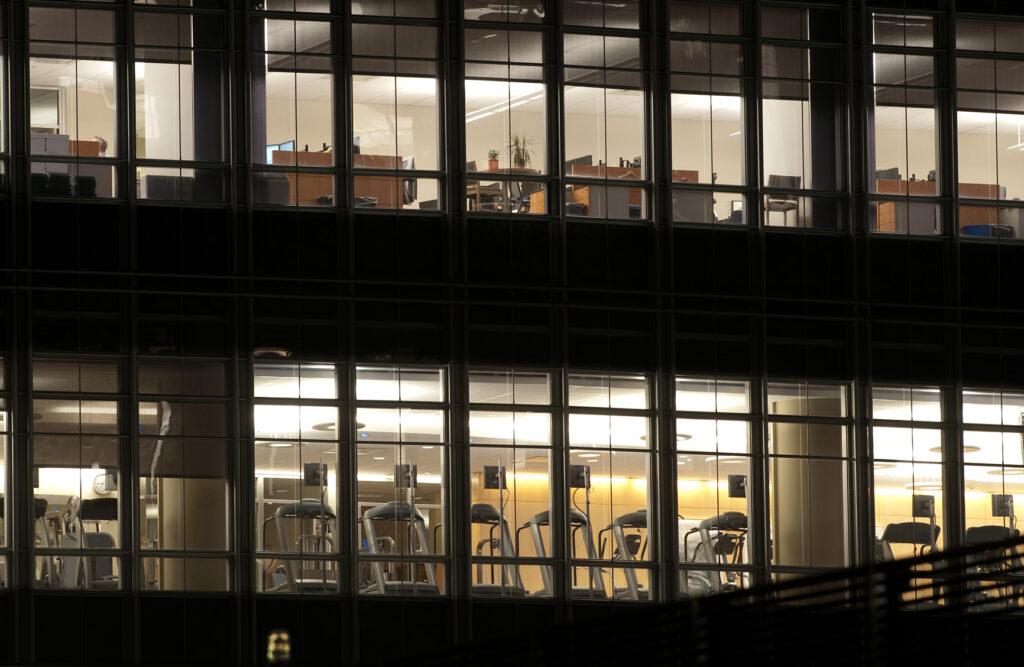
Visibility & ease of access
Where the location of your gym is can have a big impact on how well it will work for your business. When looking at locations, think about how easy it will be for people to spot your club.
Will they drive or walk by it often? Is it near other places they may visit regularly? How easy is it to get to?
When people know where your gym is, they’ll be more likely to think of joining. And when it’s easy to use the gym, they’re more likely to stick with you.
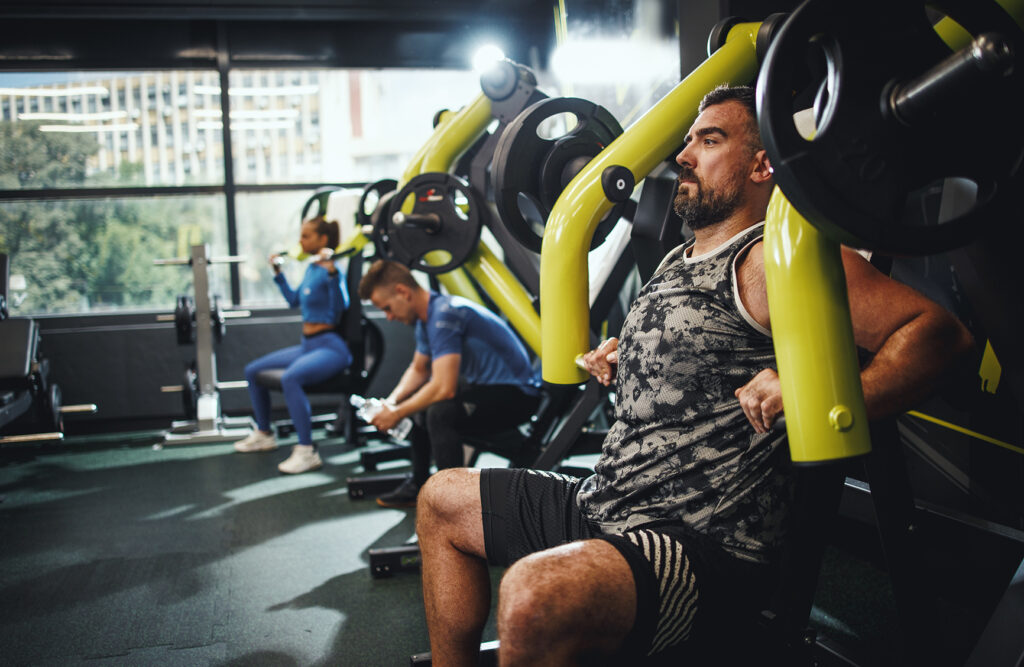
Legal & building considerations
Commercial buildings are categorised by what they can be used for in the UK. Gyms and fitness clubs have traditionally been categorised as entertainment venues. Mainly due to high noise levels and footfall.
Previously Use Class D2, gyms now fall under Use Class E – for commercial, business and service use. Selecting a gym location that’s already Class E can mean that you may not need to get planning permission to change the use of a building. Especially if there are no planning conditions mentioning the use class and you’re not making structural changes.
Choosing a location where there are minimal requirements in this area can help keep costs down.

Parking
Unless you’re planning on opening a gym in a city centre where few people use cars to get around, parking is important. Members and your gym staff are all likely to want to park somewhere.
If you don’t have enough spaces, or it’s expensive to park, attracting and retaining members becomes tough. Consider how parking will work at busy times – like when group fitness classes start/finish.

Size & facilities
Think about your planned offering. This will play a significant role in which locations will work for your gym. For example, if you want to run classes, you’ll need space for studios or enough room on the gym floor.
Size will influence how many members you can accommodate and the atmosphere of your club. There’s a fine line between buzzing and packed. And an empty gym can also be off putting for some members.
When looking at potential gym locations, think about what the layout may look like for your new club. Consider amenities you’ll need – like changing rooms. Understand the changes you may need to make to accommodate everything.
Also think to the future. Do you want to grow into the space and expand? Can your location accommodate that?

Cost & lease
The cost of opening a gym can quickly stack up. And the site you choose for your gym can take up a sizeable chunk of the investment you’ll need to make. Location plays a big role in how much it will cost to secure the best space for your gym.
Usually it’s an ongoing cost too. Most likely you’ll have a lease. Leases are usually open to negotiation – most owners will seek legal advice to review and understand terms.
Think about the costs that might be involved in refurbishing the space to make it work for your planned gym. Understand what costs you’ll be responsible for when it comes to the building.

Competition
A little competition never hurt anyone! It can keep you on the top of your game. And show that there’s demand for fitness clubs in a specific area.
You need to know about your local competition though. If you’re going to invest in a latent demand report from Leisure DB, you’ll get a detailed market analysis. As a starting point, be aware of any competitors near your preferred location.
Have a gym location in mind
Once you have a location in mind, you’re ready to work with the team at Leisure DB. That way, you’ll have a better idea if it’ll really be the best location for your new gym or fitness club. And you’ll know if you’ll be able to attract enough members to make it work.
Create a shortlist of sites
TipHave a few options in mind for your new club? The Leisure DB team will be able to work with you to provide a solution to narrow that list down. So, you then only need to invest in a full site analysis for the best option.
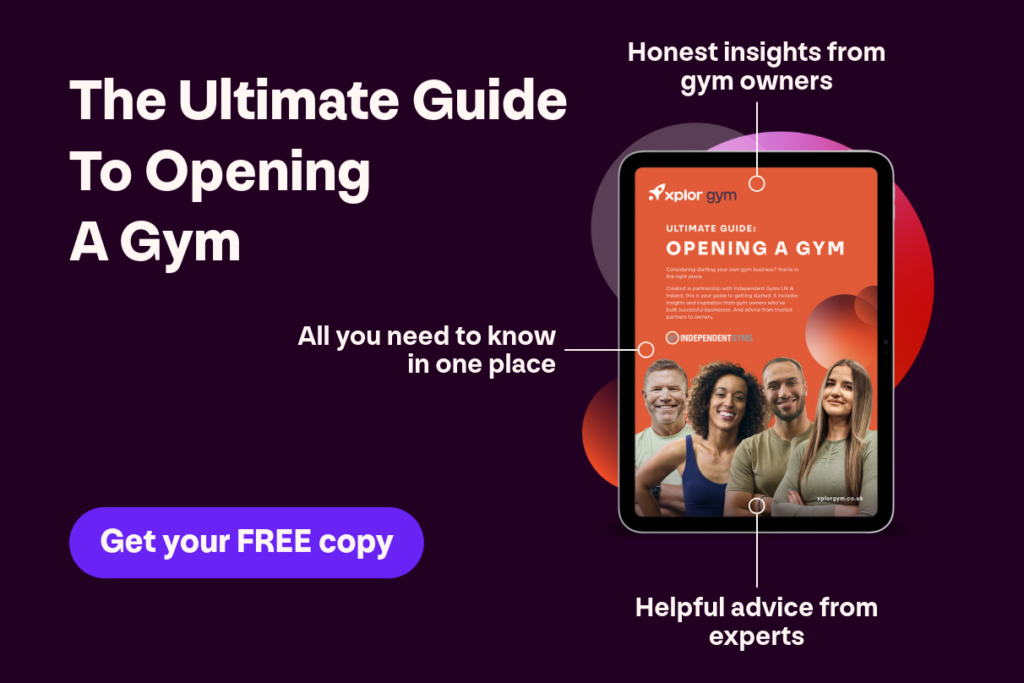
Best places to open a gym
The best places to open a gym are areas where you’ll be able to attract enough members to make your business work. There are many factors that make a location attractive and the right research will really let you know if demand is sufficient.
Honestly, the best place to open a gym will be different for every business. There’s no-one-size-fits all answer. With the right mix of industry and consumer insight you can find the best location for the new gym you want to open.
Generally places where you’ll often find successful gyms and fitness clubs include:
Retail parks
Retail parks are shopping developments located outside of town and city centres. Often they’ll include big chain names and supermarkets. And that means they have the potential to bring visibility, footfall, and parking for gyms.
City centres
Many city centres are packed during the week with commuters. Creating an audience for gyms and fitness clubs.
The type of club that can operate in a city centre can be restricted to formats that work for smaller spaces. Costs can be higher and you can usually demand a higher gym membership price.
Town centres
Likewise, town centres can work well for gyms and fitness clubs. Shoppers, workers, local residents – footfall can be high. Parking is a consideration in identifying which town centre locations will work.
With recent increases in home and hybrid working patterns, town centre locations can offer an alternative to other areas.
Near transport hubs
Gyms located near train stations and other public transport hubs can attract commuters. People who want to squeeze a workout in on their way to work/home. Plus, it can be a way to bring in people who can’t or prefer not to drive.
Accessibility can be an issue though. If a train line makes it hard to access a club, potential member numbers may be impacted.
The wrap up…
Location plays a big role in the success of gyms and fitness clubs. Perhaps even the biggest role.
Choosing the best location for a gym you want to open is an important decision. There are a lot of factors that influence how well you’ll do in a certain location.
Basing your decision on gut instinct and guess work is risky. You need to fully understand exactly how many members you’d realistically be able to win.
Successful owners and operators of all shapes and sizes have one thing in common. When opening a new gym, they choose to invest in a site analysis.
An accurate, realistic site analysis. One from the only market intelligence company that those in the UK health & fitness industry trust – Leisure DB. So, it’s based on 20+ years of experience, the most complete fitness industry data available, and trusted consumer profiling.
This is the most effective way to make sure you’re opening a gym in a location where you’ll be able to thrive.
Planning to open a new gym? Looking at gym locations? Let us introduce you to our partners at Leisure DB.
Get in touch to chat with our team
Power up your business & stay in the know

by Xplor Gym
-
First published: 12 August 2024
Written by: Xplor Gym
